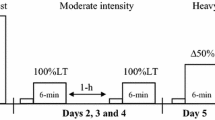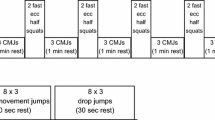Summary
The purpose of this study was to investigate the effects of repeated high-intensity intermittent training programs interspaced by detraining on human skeletal muscle and performances. First, nineteen subjects were submitted to a 15-week cycle ergometer training program which involved both continuous and high-intensity interval work patterns. Among these 19 subjects, six participated in a second 15-week training program after 7 weeks of detraining. Subjects were tested before and after each training program for maximal aerobic power and maximal short-term ergocycle performances of 10 and 90 s. Muscle biopsy from the vastus lateralis before and after both training programs served for the determination of creatine kinase (CK), hexokinase, phosphofructokinase (PFK), lactate dehydrogenase (LDH), malate dehydrogenase, 3-hydroxyacyl-CoA dehydrogenase (HADH) and oxoglutarate dehydrogenase (OGDH) activities. The first training program induced significant increases in all performances and enzyme activities but not in CK. Seven weeks of detraining provoked significant decreases in maximal aerobic power and maximal 90 s ergocycle performance. While the interruption of training had no effect on glycolytic enzyme markers (PFK and LDH), oxidative enzyme activities (HADH and OGDH) declined. These results suggest that a fairly long interruption in training has negligeable effects on glycolytic enzymes while a persistent training stimulus is required to maintain high oxidative enzyme levels in human skeletal muscle. The degree of adaptation observed after the second training program confirms that the magnitude of the adaptive response to exercise-training is limited.
Similar content being viewed by others
References
Boobis LH, Williams C, Wootton SA (1983) Influence of sprint training on muscle metabolism during brief maximal exercise in man. J Physiol 342:36P-37P
Bouchard C (1986) Genetics of aerobic power and capacity. In: Malina RM, Bouchard C (eds) Sport and human genetics. Human Kinetics, Champaign Il, pp 59–88
Costill DL, Fink WJ, Hargreaves M, King DS, Thomas R, Fielding R (1985) Metabolic characteristics of skeletal muscle during detraining from competitive swimming. Med Sci Sports Exerc 17:339–343
Coyle EF, Martin III WH, Bloomfield SA, Lowry OH, Holloszy JO (1985) Effects of detraining on response to submaximal exercise. J Appl Physiol 59:853–859
Duncan DB (1955) Multiple range and multiple F test. Biometrics 11:1–42
Green HJ, Thomson JA, Daub BD, Ranney DA (1980) Biochemical and histochemical alterations in skeletal muscle in man during a period of reduced activity. Can J Physiol Pharmacol 58:1311–1316
Green HJ, Reichmann H, Pette D (1983) Fibre type specific transformations in the enzyme activity pattern of rat vastus lateralis muscle by prolonged endurance training. Pflügers Arch 399:216–222
Henriksson J, Reitman JS (1977) Time course of changes in human skeletal muscle succinate dehydrogenase and cytochrome oxidase activities and maximal oxygen uptake with physical activity and inactivity. Acta Physiol Scand 99:91–97
Houston ME, Bentzen H, Larsen H (1979) Interrelationships between skeletal muscle adaptations and performance as studied by detraining and retraining. Acta Physiol Scand 105:163–170
Houston ME, Froese EA, Valeriote SP, Green HJ, Ranney DA (1983) Muscle performance, morphology and metabolic capacity during strength training and detraining: a one leg model. Eur J Appl Physiol 51:25–35
Howald H (1982) Training-induced morphological and functional changes in skeletal muscle. Int J Sports Med 3:1–12
Hultman E, Bergstrom J, McLennan Andersson N (1967) Breakdown and resynthesis of phosphoryl creatine and adenosine triphosphate in connection with muscular work in man. Scand J Clin Lab Invest 19:56–66
Iyengar MR (1984) Creatine kinase as an intracellular regulator. J Musc Res Cell Motil 5:527–534
Jones NL, McCartney N, Graham T, Spriet LL, Kowalchuk JM, Heigenhauser JF, Sutton JR (1985) Muscle performance and metabolism in maximal isokinetic cycling at slow and fast speeds. J Appl Physiol 59:132–136
Klausen K, Anderson LB, Pelle I (1981) Adaptive changes in work capacity, skeletal muscle capillarization and enzyme levels during training and detraining. Acta Physiol Scand 113:9–16
Larsson L, Ansved T (1985) Effects of long-term physical training and detraining on enzyme histochemical and functional skeletal muscle characteristics in man. Muscle Nerve 8:714–722
Lebherz HG, Petell JK, Shackelford JE, Sardo MJ (1982) Regulation of concentrations of glycolytic enzymes and creatine-phosphate kinase in fast twitch and slow twitch skeletal muscles of the chicken. Arch Biochem Biophys 214:642–656
McCartney N, Spriet LL, Heigenhauser GJF, Kowalchuk JM, Sutton JR, Jones NL (1986) Muscle power and metabolism in maximal intermittent exercise. J Appl Physiol 60:1164–1169
Meyer RA, Sweeney HL, Kushmerick MJ (1984) A simple analysis of the phosphocreatine shuttle. Am J Physiol 246:C365–377
Orlander J, Kiessling KH, Karlsson J, Ekblom B (1977) Low-intensity training, inactivity and resumed training in sedentary men. Acta Physiol Scand 101:351–362
Pette D (1975) Some aspects of supramolecular organization of glycogenolytic and glycolytic enzymes in muscle. Acta Histochem [Suppl] 15:47–68
Rehunen S, Näveri H, Kuoppasalmi K, Härkönen M (1982) High-energy phosphate compounds during exercise in human slow-twitch muscle and fast-twitch fibres. Scand J Clin Lab Invest 42:499–506
Roberts AD, Billeter R, Howald H (1982) Anaerobic muscle enzyme changes after interval training. Int J Sports Med 3:18–21
Sahlin K, Harris RC, Hultman E (1979) Resynthesis of CP in human muscle after exercise in relation to intramuscular pH and availability of O2. Scand J Clin Lab Invest 39:551–558
Saltin B, Gollnick PD (1983) Skeletal muscle adaptability: significance for metabolism and performance. In: Peachy LD, Adrian RH, Giegar SR (eds) Handbook of physiology. Sect. 10. Skeletal muscle. American Physiology Society, Bethesda, pp 555–631
Saltin B, Rowell LB (1980) Functional adaptations to physical activity and inactivity. Fed Proc 39:1506–1513
Schantz P, Henriksson J, Jansson E (1983) Adaptations of human skeletal muscle to endurance training of long duration. Clin Physiol 3:141–151
Sharp RL, Costill DL, Fink WJ, King DS (1986) Effects of eight weeks of bicycle ergometer sprint training on human muscle buffer capacity. Int J Sports Med 7:13–17
Shenton DW Jr, Heppenstall RB, Chance B, Glasgow SG, Schnall MD, Sapega AA (1986) Electrical stimulation of human muscle studied using 31P-nuclear magnetic resonance spectroscopy. J Orthopaedic Res 4:204–211
Simoneau JA, Lortie G, Boulay MR, Bouchard C (1983a) Test of anaerobic alactacid and lactacid capacities. Description and reliability. Can J Appl Sport Sci 8:266–270
Simoneau JA, Lortie G, Boulay MR, Hamel P, Lesage R, Thériault G, Bouchard C (1983b) Human muscle enzyme alteration after aerobic and anaerobic training. Can J Appl Sport Sci (Abstr) 8:217
Simoneau JA, Lortie G, Boulay MR, Thibault MC, Bouchard C (1985) Skeletal muscle histochemical and biochemical characteristics in sedentary male and female subjects. Can J Physiol Pharmacol 63:30–35
Simoneau JA, Lortie G, Boulay MR, Marcotte M, Thibault MC, Bouchard C (1986a) Inheritance of human skeletal muscle and anaerobic capacity adaptation to high-intensity intermittent training. Int J Sports Med 7:167–171
Simoneau JA, Lortie G, Boulay MR, Thibault MC, Bouchard C (1986b) Repeatability of fibre type and enzyme activity measurements in human skeletal muscle. Clin Physiol 6:347–357
Author information
Authors and Affiliations
Rights and permissions
About this article
Cite this article
Simoneau, J.A., Lortie, G., Boulay, M.R. et al. Effects of two high-intensity intermittent training programs interspaced by detraining on human skeletal muscle and performance. Europ. J. Appl. Physiol. 56, 516–521 (1987). https://doi.org/10.1007/BF00635363
Accepted:
Issue Date:
DOI: https://doi.org/10.1007/BF00635363




